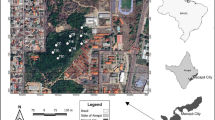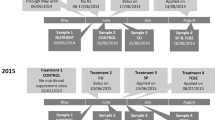Abstract
The death of buzzards (Buteo buteo) found in fodder and sugar beet fields treated with granular carbofuran was investigated. To determine if there was a causal relationship between carbofuran treatment and bird mortality, earthworms of a specific fodder beet field as well as the crop contents of dead buzzards were analyzed for carbofuran contamination. Earthworms of the fodder beet field contained carbofuran concentrations up to 3.2 mg/kg, while remains of earthworms and carbofuran were detected in all buzzard crop contents. The carbofuran concentrations found in the earthworms as well as in the crops of the buzzards corroborate the suspicion that the buzzards found on fodder and sugar beet fields treated with granular carbofuran had died of secondary poisoning with carbofuran via contaminated earthworms.
Similar content being viewed by others

References
Balcomb R (1983) Secondary poisoning of red-shouldered hawks with carbofuran. J Wildl Manage 47(4):1129–1132
Balcomb R, Bowen CA, Wright D, Law M (1984a) Effects on wildlife of AT-planting corn applications of granular carbofuran. J Wildl Manage 48(4):1353–1359
Balcomb R, Stevens R, Bowen CA (1984b). Toxicity of 16 granular insecticides to wild-caught songbirds. Bull Environ Contam Toxicol 33:302–307
De Lavaur E, Carpentier-Le Sech J, Prin AM (1991) Etude de la distribution et de la persistance post mortem du carbofuran chez la caille japonaise (Coturnix coturnix japonica). Gibier Faune Sauvage 8(3):65–77
Deutsche Forschungs Gemeinschaft (1991) Carbosulfan, Carbofuran. Rückstands-analytik von Pflanzenschutzmitteln. Verlag Chemie mbH. 658(344)1–658(344)14
Fleming WJ, Heinz GH, Franson JC, Rattner BA (1985) Toxicity of Abate® 4E (temephos) in mallard ducklings and the influence of cold. Environ Toxicol Chem 4:193–199
Flickinger EL, King KA, Stout WF, Mohn MM (1980) Wildlife hazards from Furadan 3G applications to rice in Texas. J Wildl Manage 44(1):190–197
Glutz von Blotzheim UN (1964) Die Brutvögel der Schweiz. Verlag Aargauer Tagblatt AG, Aarau, Switzerland
— (1971) Handbuch der Vögel Mitteleuropas. Akademische Verlagsgesellschaft, Frankfurt am Main, FRG
Hill EF (1989) Divergent effects of postmortem ambient temperature on organophosphorus-and carbamate-inhibited brain cholinesterase activity in birds. Pesticide Biochem Physiol 33:264–275
Jenni-Eiermann S, Bachmann H, Zbinden N, Dietrich DR (1995) Greifvogel Mortalität im Zusammenhang mit der Applikation von Pfalnzenschultzmitteln im Frühling. Ornitholog. Beobachter in preparation
Kring JB (1969) Mortality of the earthworm Lumbricus terrestris L. following soil applications of insecticides to a tobacco field. J Econ Entomol 62:963
Maguire CC, Williams BA (1987) Cold stress and acute organophosphorus exposure: Interaction effects on juvenile Northern Bobwhite. Arch Environ Contam Toxicol 16:477–481
Martin PA, Forsyth DJ (1993) Survival and behaviour of captive mallard broods exposed to carbofuran-sprayed vegetation: A field experiment. Ecotoxicol 2:79–92
Martin PA, Solomon KR (1991) Acute carbofuran exposure and cold stress: Interactive effects in mallard ducklings. Pesticide Biochem Physiol 40:117–127
Mineau P (1993) The hazard of carbofuran to birds and other vertebrate wildlife. Can Wildlife Service, Technical Report Series No. 177, ISBN 0-662-20823-4, Ottawa, Canada
Rattner BA, Becker JM, Nakatsugawa T (1987) Enhancement of parathion toxicity to quality by heat and cold exposure. Pesticide Biochem Physiol 27:330–339
Rattner BA, Franson JC (1984) Methyl parathion and fenvalerate toxicity in American kestrels: Acute physiological responses and effects of cold. Can J Physiol Pharmacol 62:787–792
Smith GJ (1987) Pesticide use and toxicology in relation to wildlife: Organophosphorus and carbamate compounds. US Fish and Wildlife Service, Resource Publication 170, Washington DC, USA
Wiemeyer SN, Sparling DW (1991) Acute toxicity of four acetylcholinesterase insecticides to American kestrels, eastern screechowls and northern bobwhites. Environ Toxicol Chem 10:1139–1148
Author information
Authors and Affiliations
Rights and permissions
About this article
Cite this article
Dietrich, D.R., Schmid, P., Zweifel, U. et al. Mortality of birds of prey following field application of granular carbofuran: A case study. Arch. Environ. Contam. Toxicol. 29, 140–145 (1995). https://doi.org/10.1007/BF00213099
Received:
Revised:
Issue Date:
DOI: https://doi.org/10.1007/BF00213099



